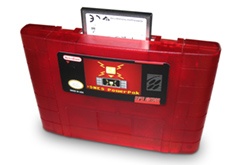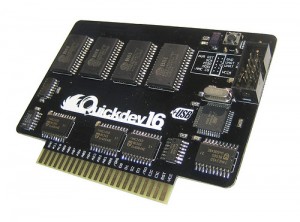Category: SNES
-
SNES Powerpak appeared!
Yea I know I’ve said I think SPC sound is kinda sucky, but this should at least be funny for some mode 7 visuals at your next chip rave.
Details:
SDRAM and DMA are used for fast game loading so you can play in seconds. This means a quick cycle for homebrew development. Now you can see your creation on real hardware instead of relying on emulators. In cart support for the DSP1 chip lets you play games like Super Mario Kart that are missing from some other SNES products. Huge 128Mbit memory means even the largest games can be played without buying hard to find memory expansions. Versatile memory mapping runs games correctly without FastROM hacking or RAM mirroring problems.
Standard FAT16 or FAT32 formatted carts are used so there is no special software to load games onto the card. Organize your games in folders any way you want for faster browsing. Compact Flash is used instead of something else like SD for maximum speed. The SNES processor is the bottleneck so the parallel CF card is around 10 times faster than the serial SD card.
The entire PowerPak system is updateable for future additions and bug fixes. All loading files are stored on the CF card for easy upgrading. Just download the most recent Mappers file below, unzip, then copy the folder to the root of your CF card. The boot ROM is socketed for easy reflashing but this will hopefully never be needed. If it is needed and you do not have a programmer, you just pay the shipping to get your SNES PowerPak here and I will reflash then mail it back free.
via RetroZone.
-
Quickdev16 SNES dev cart appeared
I’ve said it before, but I am not that big of a fan of SPC. That being said, it would be cool to see what people can cook-up with this.
Quickdev16 is a developer cartridge for the Super Nintendo and it can be used to upload homebrew roms to the console. You can upload rom images tup to the size of 16Mbit. Currently NTSC and PAL SNES consoles are supported by using a dedicated CIC chip on the Quickdev16 cartridge. Homebrew roms and games that depend on the save game feature or that use DSP chips are not supported by this release. You can connect the cartridge via usb to your computer and upload roms with a command line tool. Currently Linux,OS X and Windows software builds are available.
Important Note: If you don’t know how to use the comandline and just interested in runing games on your Super Nintendo, this isn’t the right project for you. This is a developer tool and not a plug and play solution.
Features:
- * 16 MBit SRAM for ROM storage
- * ATmega644 MCU for housekeeping
- * USB connection for ROM upload
- * ucon64 software compatibel
- * PAL/NTSC CICs are supported
- * Lo/Hi ROM support
- * Reset trigger and sniffer from cartridge possible
- * AVR USB Bootloader for quick firmware updates
- * Snes bootloader intro
Via hacakday.
-
GameSetWatch Interviews Classic Composer Hiroyuki Iwatsuki
GSW has an interesting interview with classic and current composer Hiroyuki Iwatsuki, who worked on games for The NES, the SNES, and more recently XBOX 360. The interview disucsses some of the difficulties composers had on the older hardware, and compares and contrasts it to today’s modern games. An excerpt:
GSW: What are some of the important differences between composing for the XBox 360 compared with your work on the 16-bit Super Nintendo?
Iwatsuki: The biggest difference between the Super Famicom and the Xbox 360 is the difference in memory. You could almost fit the contents of a Super Famicom cart within the memory space allotted to the music of a single Xbox 360 game. For Omega Five it adds up to a few megabytes because of the high quality of the recorded sounds. The Xbox 360 uses 48 kHz sound output, so naturally we were using those specifications. In retro mode, we consciously lowered the sound source to between 12 and 16 kHz, then rendered these files at 48 kHz to give it an antique quality. Even the retro tracks are large files, which is the sort of thing you could not get away with on the Super Famicom. Back then we were forced to be inventive and make sacrifices on sound quality so that the hardware could handle it.



